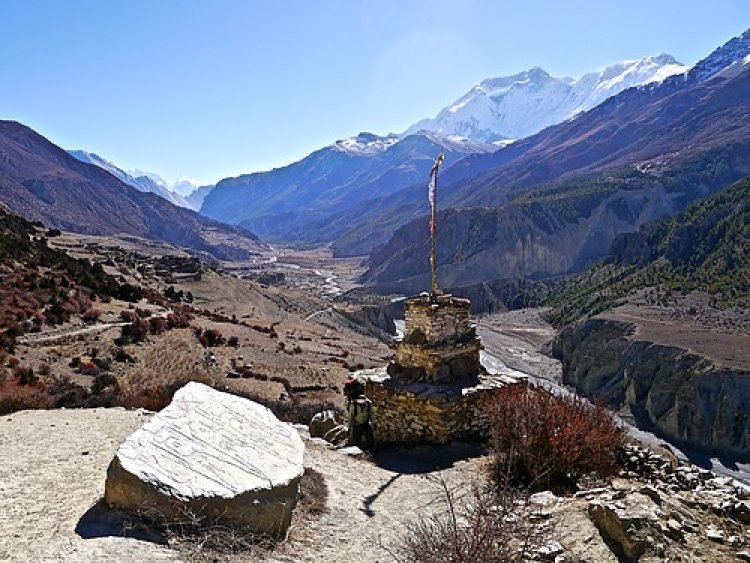Manang District: Unveiling Nepal's Annapurna Gem
Discover the wonders of Manang District in Nepal, nestled in the heart of the Annapurna range. Unveil breathtaking landscapes, cultural treasures, and adventure opportunities in this Himalayan paradise.

Introduction:
Nestled within the breathtaking landscapes of the Annapurna mountain range, the Manang District stands as a pristine jewel in the heart of Nepal. Boasting diverse topography, rich flora and fauna, and a vibrant cultural tapestry, Manang is a haven for nature enthusiasts, adventure seekers, and those yearning for an authentic Himalayan experience. In this comprehensive guide, we delve into the wonders of Manang District, exploring its natural beauty, cultural heritage, adventure opportunities, and sustainable tourism practices.
Discovering the Natural Beauty of Manang District
-
Geography and Topography:
The Manang District, situated in the central part of Nepal, is renowned for its diverse topography. Spanning altitudes from approximately 2,000 meters to over 6,000 meters, the region encompasses lush forests, alpine meadows, rugged mountain terrains, and pristine glacial lakes. The district is flanked by the Marsyangdi River to the east and the Kali Gandaki River to the west, offering a stunning backdrop against the majestic peaks of the Annapurna range. -
Flora and Fauna:
Manang's varied altitudes create a unique environment that supports a rich variety of flora and fauna. Lower elevations feature lush forests dominated by rhododendron, oak, and pine trees, providing a vibrant display of colors. As one ascends, the landscape transitions to alpine meadows and scrublands, hosting wildflowers and medicinal herbs. The region is home to endangered species like the snow leopard, Himalayan tahr, blue sheep, and musk deer. Bird enthusiasts can revel in the diverse avifauna, including the Himalayan monal and lammergeier.
Immerse Yourself in Manang's Cultural Tapestry
-
The Manangi People:
The Manang District is home to the Manangi people, an ethnic group with a distinct culture, language, and traditions deeply rooted in their Tibetan heritage. The Manangi people predominantly practice Tibetan Buddhism and the ancient Bon religion. The unique practice of polyandry, traditional craftsmanship, and their historic involvement in the salt trade between Tibet and Nepal are emblematic of the Manangi way of life. -
Language and Traditions:
The Manangi people communicate in their native dialect, Manangba, belonging to the Sino-Tibetan language family. Traditional customs, monasteries, chortens, and prayer flags are integral to their spiritual beliefs. Visitors can witness the locals donning traditional attire, including the colorful chuba for women and woolen trousers for men, reflecting the cultural richness of Manang.
Festivals and Celebrations in Manang
-
Tiji Festival:
Tiji, a significant annual festival celebrated in the Upper Mustang region, is also observed by the Manangi people due to their cultural connections. The three-day event, held in May, commemorates the victory of the Buddhist deity Dorje Jono over a menacing demon. Visitors can witness elaborate masked dances, traditional music, and rituals performed by monks during this vibrant celebration. -
Yartung Festival:
Yartung, celebrated in August, marks the end of the harvest season. The festival is characterized by horse racing, archery competitions, traditional dancing, and feasting. Yartung offers visitors a lively atmosphere and a chance to partake in the local community's joyous celebrations.
Savoring Manang's Unique Cuisine
-
Traditional Dishes:
Manangi cuisine reflects Tibetan influences and local agricultural practices. Must-try dishes include Tsampa (roasted barley flour), Thukpa (noodle soup), Momos (dumplings), and the unique Yak Cheese, which is made from the milk of yaks grazing in the high-altitude pastures.
Adventure Awaits in Manang
-
Trekking in Manang:
Renowned as a trekker's paradise, Manang offers iconic routes like the Annapurna Circuit and the Tilicho Lake Trek. Trekkers can explore diverse landscapes, picturesque villages, and cross the challenging Thorong La Pass, situated at an altitude of 5,416 meters. -
Mountaineering in Manang:
For mountaineering enthusiasts, Pisang Peak and Chulu East present challenging yet rewarding climbs. Pisang Peak, at 6,091 meters, offers a moderate ascent, while Chulu East, at 6,584 meters, is a more challenging endeavor. -
Mountain Biking and Paragliding:
Thrill-seekers can enjoy mountain biking through the lower section of the Annapurna Circuit, experiencing diverse terrains. Paragliding, though limited, provides a unique perspective of the region's stunning landscapes.
Must-Visit Places in Manang
-
Gangapurna Lake:
Gangapurna Lake, near the village of Manang, is a serene glacial lake offering breathtaking views of the Annapurna range. A short hike rewards visitors with panoramic vistas of the turquoise waters and surrounding peaks. -
Milarepa Cave:
The Milarepa Cave, near Bhraka, is a significant pilgrimage site linked to the revered Tibetan yogi Milarepa. The cave provides spiritual solace and scenic views of the Marsyangdi River Valley.
Sustainable Tourism in Manang
-
The Annapurna Conservation Area Project (ACAP):
ACAP, established in 1986, plays a pivotal role in conserving Manang's ecological, cultural, and natural resources. Through initiatives such as biodiversity conservation, community development, and sustainable tourism practices, ACAP ensures responsible tourism in the region. -
Eco-Friendly Travel Tips:
Travelers can adopt eco-friendly practices, including the Leave No Trace principles, water and energy conservation, and wildlife preservation. By being mindful of their impact, visitors contribute to the preservation of Manang's environment.
Supporting Local Communities
-
Hiring Local Guides and Porters:
Supporting local livelihoods, hiring local guides and porters ensures that tourism benefits the community directly. These individuals offer valuable insights into the region's culture and environment. -
Staying in Locally-Owned Accommodations:
Opting for locally-owned guesthouses and lodges contributes to the local economy while providing visitors with an authentic experience of Nepalese hospitality. -
Participating in Community Initiatives:
Engaging in community-based tourism projects, contributing to local development projects, and purchasing directly from local artisans are ways visitors can actively support Manang's communities.
Conclusion:
In conclusion, the Manang District beckons travelers with its unparalleled beauty, rich cultural heritage, and thrilling adventures. From the vibrant traditions of the Manangi people to the exhilarating treks and mountaineering challenges, Manang offers a journey into the heart of the Himalayas. As you explore this enchanting district, remember to tread lightly, embrace sustainable practices, and immerse yourself in the unique charm of a destination untouched by mass tourism. Manang awaits, promising an authentic Himalayan experience that will linger in your memory for years to come.
What's Your Reaction?








































































































